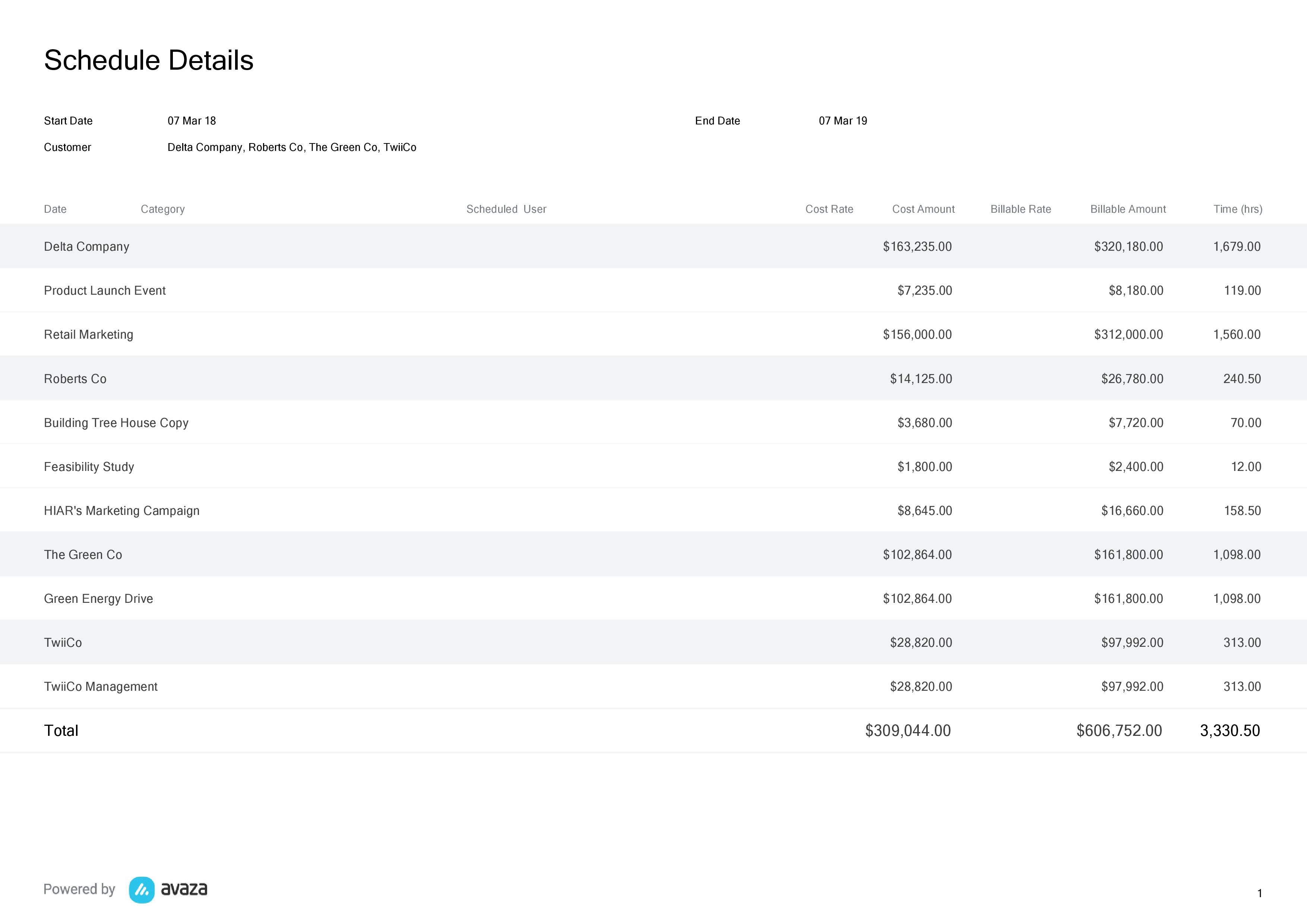The Schedule Details Report provides better insight into your project schedule for any date range. You can use this report to forecast revenue for your business, customers, projects, and compare the cost & billable amounts to gain visibility into your profit margins.
 Figure: Grouped by Project and User
Figure: Grouped by Project and User
A few reasons to use this report
- Forecast revenue and cost amounts booked for the next week, month, quarter or year
- Calculate the margin of schedule and optimize the schedule for profitability
- Assess resource requirements based on bookings and make necessary changes to deliver on the project schedule
- Get an overview of how projects are resourced
- Optimize how a resource is utilized and view the billable vs non-billable activities a user is assigned to
- Export your Resource Scheduling plan as a PDF
 Figure: Grouped by Customers and Projects with hidden individual entries
Figure: Grouped by Customers and Projects with hidden individual entries
Report Parameters.
This report runs by default for next week, it is highly customizable and you can choose from multiple groupings, filters and column options, along with other useful report parameters.
Date Range:
The following predefined date range options are available.
- Next Week
- Next Month
- Next 30 Days
- Next 60 Days
- Next 90 Days
- Next Year
- This Week
- This Month
- Last Week
- Last Month
- Last 30 Days
- Last 60 Days
- Last 90 Days
- Year To Date
- Last Year
- Custom Date Range(allows you to choose a custom date range in the next parameter)
Start & End Date:
Enter a custom date range to run the Schedule details report for. This date range is for the schedule entries.
Groupings
Many of our reports allow you to group data. The Schedule Details Report has two available grouping options:
- Primary Grouping
- Secondary Grouping
These groupings include the following options:
- Date
- Customer
- Project
- Category
- Scheduled User
- Task
- Section
- Month
- Billable?
- Week
- Scheduled By
We subtotal the duration, cost and billing amounts when data is grouped. The only exception to this is when a chosen grouping has projects in multiple currencies. In that case amount fields display N/A as amounts from different currencies can’t be added up.
Customers: Select the customer(s) you want to run the report for. You can select one or more customers as needed.
Projects: Select the project(s) you want to run the report for. You can select one or more projects as needed. You can only choose a project after one or more customers have been chosen.
Categories: Filter based on timesheet categories and leave types the schedule bookings are added for. This is very useful if you only need to see a certain type of schedule booking.
User Tags: User Tags can be created and assigned to team members as needed. These can be useful to filter the user list down to just one team, for example, design team, customer support etc.
Users: Choose specific users you want to run the report for.
Schedule by: Filter the report down to bookings made by the selected user
Only Billable?: To view only those schedule assignments that have billable timesheet categories, enable the “Only Billable” checkbox.
Rounding: You can also apply rounding to the scheduled assignments based on your account settings.
Time Format: Choose between Decimal Hours (H.xx) or Hours Minutes (HH:MM)
Show Columns
- Notes
- Project Tags
- Project Categories
- Scheduled By
- Billable?
- Tasks
- Sections
- Cost Rate/Amount
- Billable Rate/Amount
- Created Date
- Month (defined as a calendar month)
You can add up to 11 columns on this report.
Hide Individual Entries [checkbox]: Hide individual schedule assignments on the report output. The display will only include any available groupings you had selected, as well as the duration and amount fields that can be aggregated on grouping rows.
Start/End Timezone: Choose whether schedule assignments Start & End times should be shown in User Timezone or Account Timezone.
Project Tags: Filter the projects based on project tags.
Project Categories: Filter projects based on project categories.
Created Date From & To: Filter the schedule assignments based on the dates they were created on. This allows you to audit when the assignments were created.
Project Archive Status: Use this parameter to filter the reports to see the schedule details based on the Archive Status of the projects. This is a multi-select field and you can select Active, Archive, or both the statuses to filter the report output. Once this filter is applied, the report will display only those schedules that are linked to the projects in the selected status. Please note that selecting an option from this parameter also filters the lists in other relevant parameters like Customers, Projects, and Categories etc.
User Archive Status: Use this parameter to filter the reports to see the schedule details based on the Archive Status of the users. You can select Active, Archive, or both the statuses to filter the report output. Once this filter is applied, the report will display the schedule details for only the users in selected status. Please note that selecting an option from this parameter also filters the lists in other relevant parameters like Customers, Projects, Categories, Users, and User Tags.
We hope this guide was useful. Need further help with the Schedule Details report? Please contact our support team via chat or email.
